Yellowing Tomato Leaves: Top Reasons and Expert Solutions for Healthier Plants
•Posted on April 19 2024
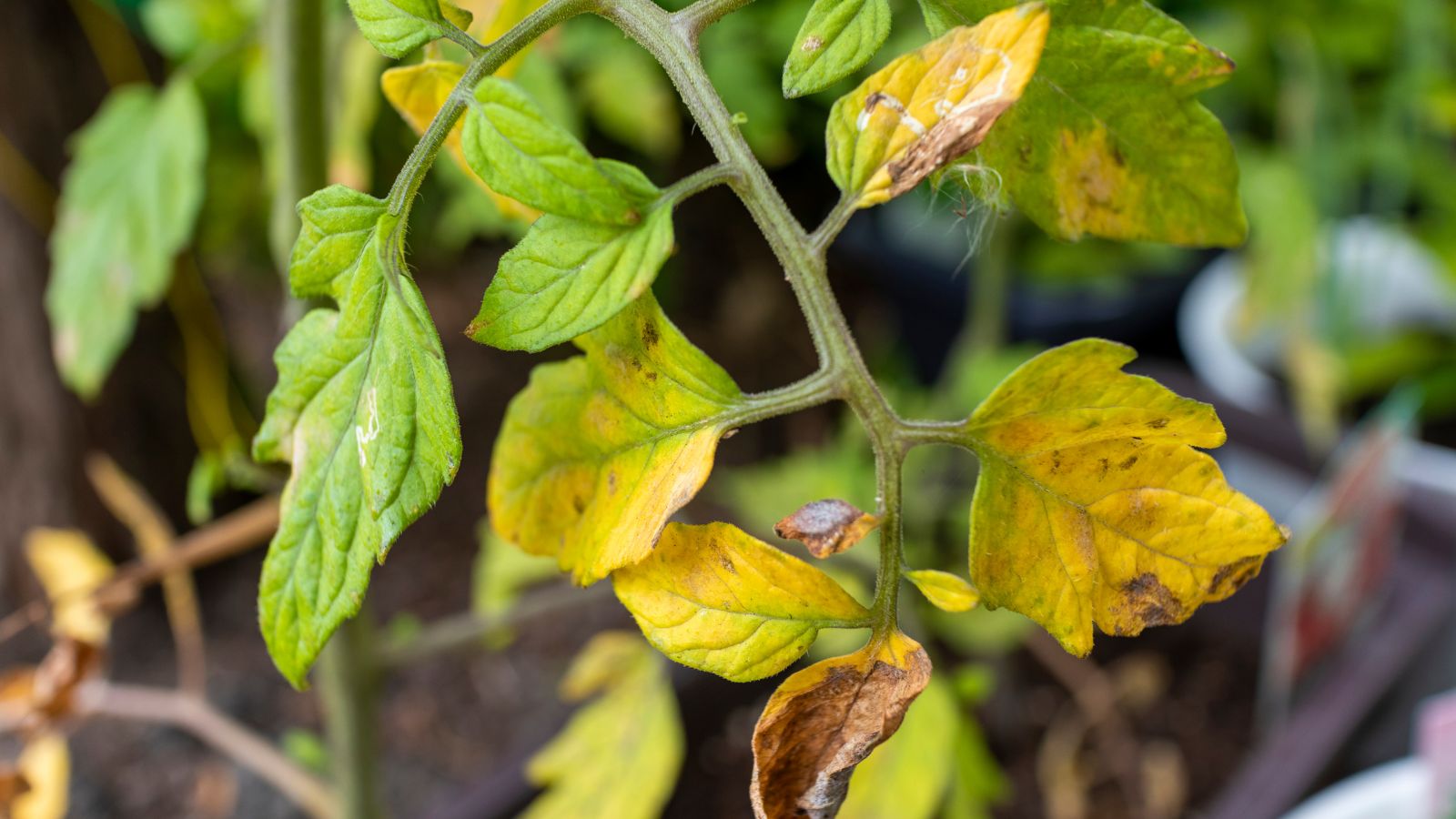
Tomatoes are a staple in many home gardens, prized for their versatility and flavor. However, one common issue that can plague tomato growers is the dreaded yellowing of leaves. If you've ever wondered, "Why are my tomato plants turning yellow?" you're not alone. In this comprehensive guide, you'll learn how to identify and address the causes behind yellowing tomato leaves to help your plants thrive. We'll cover:
- Common causes of yellowing leaves: Understand how nutrient deficiencies, watering problems, environmental stress, pests, and diseases can affect your tomato plants.
- Diagnosing yellow leaves: Learn what different symptoms, such as yellow leaves with brown spots, may indicate about your plant's health.
- Effective solutions: Discover actionable steps for nutrient supplementation, adjusting watering practices, improving soil conditions, and managing pests and diseases.
- Preventative care: Get tips on maintaining healthy tomato plants through proper fertilization timing and ongoing maintenance practices.
By understanding these factors, you can ensure your tomato plants remain healthy and productive.
Recommended for You:

Why Are My Tomato Plants Turning Yellow?

Understanding why tomato leaves turn yellow is key to solving the problem and ensuring your plants stay healthy. Here are some of the most common causes behind this issue and how they can affect your tomato plants:
- Nutrient deficiencies:
- Nitrogen deficiency: Causes overall yellowing, often starting with older leaves.
- Magnesium deficiency: Leads to yellowing between leaf veins.
- Iron deficiency: Typically shows as yellowing on younger leaves.
- Poor soil quality can worsen these deficiencies by limiting nutrient availability.
- Watering practices:
- Overwatering: Saturates the soil, depriving roots of oxygen and potentially causing root rot.
- Underwatering: Leads to dehydration, hindering nutrient absorption.
- Proper watering balance is essential for maintaining healthy foliage.
- Environmental stressors:
- Extreme temperatures: Cold stress can reduce nutrient uptake.
- Poor soil drainage: Can cause waterlogged roots, leading to yellowing.
- Inadequate sunlight: Too much direct sun may result in leaf scorch.
- Diseases:
- Early blight and fusarium wilt: Often appear as yellow spots that gradually expand, potentially leading to leaf drop.
- Fungal infections can spread rapidly, requiring early diagnosis and management.
Related Post: The Difference Between Fungal and Bacterial Infections in Your Plants
What Causes Yellow Leaves on Tomato Plants?
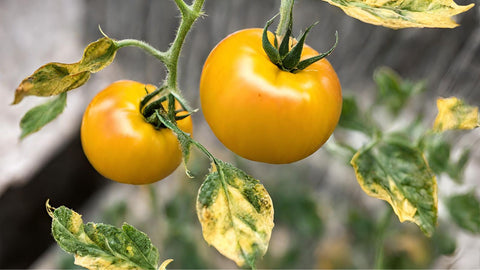
Yellow leaves on tomato plants can be attributed to several factors:
-
Nutrient deficiencies: Lack of essential nutrients like nitrogen, magnesium, or iron can cause leaves to turn yellow. This deficiency often manifests as chlorosis, where the leaves lose their green color due to insufficient chlorophyll production.
-
Overwatering or underwatering: Inconsistent watering practices can stress the plants, leading to yellowing of leaves. Overwatering can drown the roots and deprive them of oxygen, while underwatering can result in dehydration and nutrient uptake issues.
-
Environmental stress: Extreme temperatures, poor soil drainage, and improper sunlight exposure can stress tomato plants, causing their leaves to turn yellow.
-
Pests and diseases: Certain pests, such as aphids and whiteflies, can suck the sap from tomato plants, causing damage and yellowing of leaves. Diseases like early blight and fusarium wilt can also lead to yellow spots on tomato leaves.
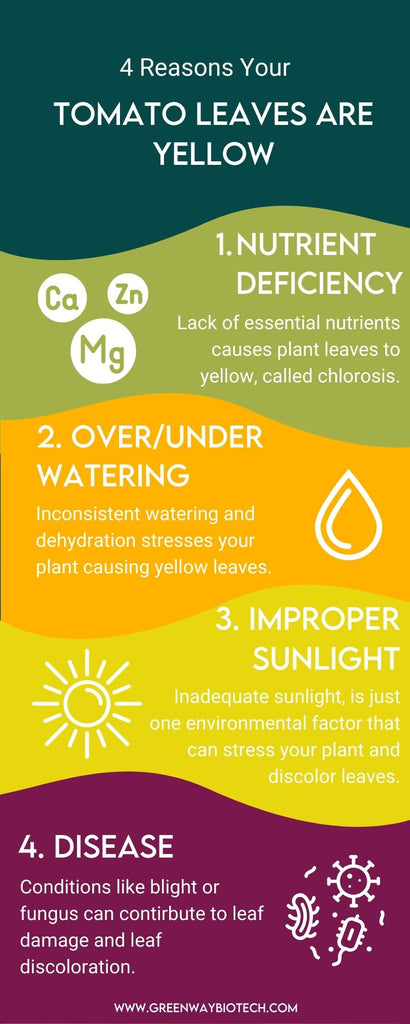
What Do Yellow Tomato Leaves With Brown Spots Indicate?

Yellow tomato leaves with brown spots are often a sign of fungal or bacterial diseases, such as early blight or septoria leaf spot.
These diseases typically start as small, dark spots on the leaves, which gradually enlarge and turn yellow or brown.
Proper sanitation, including removing infected leaves and practicing crop rotation, can help prevent the spread of these diseases.
Related Post: How to Save Tomato Seeds From Fresh Tomatoes
How Do You Fix Yellow Leaves on Tomato Plants?
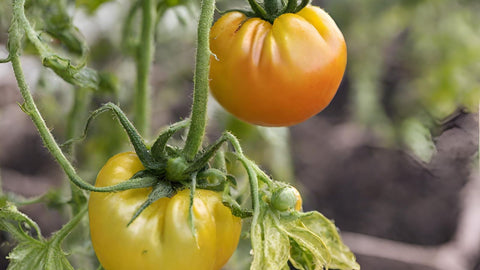
To address yellow leaves on tomato plants, consider the following remedies:
-
Nutrient supplementation: Use a balanced fertilizer to provide essential nutrients to the plants. Our Tomato Fertilizer 4-18-38 Plus Micronutrients is an excellent choice, as it contains a precise blend of nutrients tailored to meet the needs of tomato plants.
-
Adjust watering practices: Ensure that the plants receive adequate but not excessive water. Monitor soil moisture levels and water deeply and infrequently to promote healthy root growth.
-
Improve soil drainage: Amend the soil with organic matter to improve drainage and prevent waterlogging, which can contribute to root rot and yellowing of leaves.
-
Control pests and diseases: Inspect the plants regularly for signs of pest infestation or disease. Use natural or organic pest control methods whenever possible, and promptly remove infected plant material to prevent the spread of disease.
Recommended for You:

Can You Save Yellow Tomato Leaves? When to Prune and When to Treat
Yellow tomato leaves can sometimes be revived and turned green again, but the outcome depends on the severity of the issue and the underlying cause. Understanding when to treat the leaves and when to prune them is crucial for promoting plant health:
- Treatable yellow leaves:
- If the yellowing is due to nutrient deficiencies, such as nitrogen, magnesium, or iron, supplementing with the right fertilizer can restore the leaves' green color. For best results, choose a fertilizer with a balanced mix of essential nutrients, including micronutrients.
- When environmental stress is the cause, improving conditions like soil drainage, watering practices, and exposure to sunlight can help the leaves recover. Adjusting watering to avoid over- or underwatering, and providing shade during extreme heat, can aid in restoring leaf health.
- Irreversible yellowing:
- Severely damaged or diseased leaves may not recover fully, even with improved care. Diseases like early blight or fusarium wilt can cause permanent damage, making it necessary to remove these leaves to prevent the spread of infection.
- Pruning yellow leaves is recommended if the affected foliage is showing signs of disease, such as brown spots or a brittle texture. This not only helps limit the spread of the disease but also encourages new, healthy growth by redirecting the plant’s energy.
- When to prune yellow leaves:
- Before pruning, it's essential to identify the cause of the yellowing. If the leaves are yellowing from a nutrient deficiency or environmental stress, address these factors first. Pruning may not be necessary if the issue can be corrected and the plant shows signs of recovery.
- If the leaves are severely discolored, wilted, or covered in spots, pruning them can prevent the plant from wasting energy on damaged tissue and help redirect nutrients to healthier parts of the plant.
By properly diagnosing the cause of yellowing and taking the right steps—whether through treatment or pruning—you can improve your tomato plant's chances of thriving.
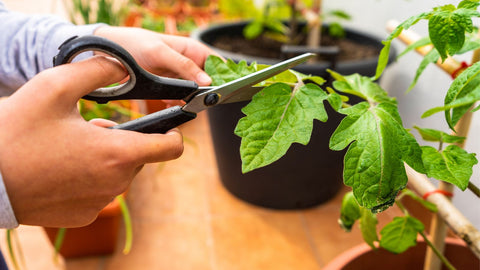
Related Post: Easy Tips to Fertilize Your Tomatoes for Better Yields
What Fertilizer is Good for Yellow Tomato Leaves?

Choosing the right fertilizer is crucial for addressing yellow leaves on tomato plants.
Tomato Fertilizer 4-18-38 Plus Micronutrients is an excellent option for several reasons:
-
Balanced nutrient formulation: This fertilizer contains a precise blend of essential nutrients, including nitrogen, phosphorus, potassium, and micronutrients like magnesium and iron, to support healthy plant growth and development.
-
Water-soluble formula: The water-soluble formulation of Greenway Biotech Tomato Fertilizer allows for easy nutrient uptake by the plants, ensuring quick and efficient absorption.
-
Micronutrient supplementation: In addition to major nutrients, this fertilizer provides essential micronutrients that are often lacking in soil, such as magnesium, iron, and zinc, which are vital for preventing yellowing of leaves and promoting overall plant health.
Recommended for You:

When to Fertilize Tomato Plants?

It's important to fertilize tomato plants at the right time to maximize their growth and productivity.
Begin fertilizing when the plants start to flower, and continue every four to six weeks throughout the growing season.
Avoid over-fertilizing, as this can lead to nutrient imbalances and other issues.
Comments
0 Comments
Leave a Comment